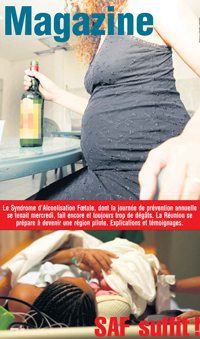Fetal alcohol syndrome
Alcoholism affects in France 2 million people, approximately 600,000 women. During pregnancy, 5% of women consume three drinks per day on average, which is already a danger to the unborn child. In France it is estimated that « All the Troubles Caused by Fetal alcohol spectrum disorder (FASD) » affect 1% of births, that is to say 7000 new children each year. This means that about 500,000 French suffer varying degrees of fetal alcohol effects. It is estimated that in industrialized countries, 1-3 in 1000 children are suffering from Fetal Alcohol Syndrome (FAS) at birth, while the percentage of children affected by the effects of alcohol on the fetus (FAE) (learning difficulties and social integration) could be much higher, around 10 per 1000 births.
THE MOTHER DRINKS, THE FETUS TOAST!
The fetus drinks what its mother drinks
Alcohol consumed by the mother pass directly by simple diffusion across the placenta. Half an hour to an hour after drinking the fetus and the mothers’ alcoholic percentage are equivalent. This alcohol passes into the fetal liver. Because of its enzymatic immaturity, it is not able to degrade alcohol to remove it. The elimination of the alcohol will be 2-3 times longer than in adults.
Alcohol is toxic to the fetus
Alcohol causes a decrease in maternal-fetal exchanges by spasm of blood vessels, causing fetal distress or death in utero.
Alcohol also has a direct toxicity on tissue formation, we speak of teratogenicity. The risk of irreversible neurological damage depends on the dose received by the fetus, and the duration of the exposure period. If alcohol is particularly harmful during the period of organogenesis, ie during the first trimester of pregnancy, toxicity is exercised throughout pregnancy, and resounding on the overall growth of the fetus as well as brain development, the brain is the organ most vulnerable of the body. Once established, the lesions are final.
TWO POSSIBLE CLINICAL PICTURES
The fetal alcohol syndrome was first described in 1968 by Lemoine who had identified in children of women who consumed large amounts of alcohol during pregnancy, morphological abnormalities of the face: short palpebral fissures (small eyes ) facies flattened, thin upper lip and philtrum flat or smooth. These children also exhibited growth retardation and behavioral disorders and cognition.
Today, the diagnosis of a child with FAS based on a combination of the following criteria, in the context of alcohol during pregnancy:
>> Growth retardation
>> Central nervous system (neurological abnormalities, developmental delays, behavioral disorders, cognitive disorders or other cognitive deficits)
>> Facial features
In France, the FAS is the leading cause of non-genetic mental retardation.
It is a term used to describe children with some of the anomalies associated with maternal alcohol consumption during pregnancy, sometimes with only small amounts of alcohol. Neurobehavioral disorders that children with FAE sometimes have may be as severe as those found in the typical form of FAS, but they often occur secondarily. Thus, the child often appear normal at birth.
Alone can be noted :
>> A discrete delay of growth or a simple slowdown
>> Most often, no malformations or minor malformations
>> But almost always emerge during the early years of learning disabilities and behavior at the origin of delay school and social integration difficulties.
Growth retardation persists. In severe forms, it is important and hopeless even with proper diet and appropriate care. Catching up to adolescence and adulthood will be only partial for plus size appreciable weight. The cranial volume remains well below normal and more so that maternal alcohol has been important during pregnancy. Malformations will sometimes require surgery during the first year. Neurological disorders persist or appear, even in children who seemed little affected in the neonatal period.
As a teenager and adult, behavioral disorders predominate: Academic Achievement and Professional are compromised. In these impressionable children, acts of petty crime are common due to lack of judgment or because of their impulsivity. They are easily depressed. Most affected live in institutionalization: 15 to 20% are found in communities for the mentally handicapped. Nearly half abuse alcohol and / or drugs.
A TRAGEDY WHICH IS AVOIDABLE
Prenatal exposure to alcohol represents a risk factor for the unborn baby at all stages of pregnancy.
This risk is common to all varieties of alcoholic beverages at the same point of consumption.
Indeed, we do not know the minimum dose below which there would be no risk to the fetus. It is recognized that the typical picture of FAS (with severe growth retardation, microcephaly, mental retardation and malformations) corresponds to a regular alcohol more than 2 drinks / day or acute alcohol consumption greater than 4 drinks on one occasion, he is now also proven that even small amounts of alcohol can cause neurological damage in the fetus. Experts now believe that the risk is from the first drink: this is why, during pregnancy, a strict abstinence should be maintained.
Screening and early treatment: two major
Early identification of FAS or FAE is an important step to understand the root cause of the behavior and learning of a child. This is the key to define the intervention but also prevent further births affected by the same problems.
Facilitate access to appropriate early intervention and can alleviate many physical, emotional, social and educational problems which children with FAS or FAE have to face.
Maternal alcoholism screening is to recognize the suffering of the woman is to overcome her modesty and her denial, is to reduce guilt, is to initiate and maintain with her a long difficult dialogue.
Since alcohol, even in small amounts, can have adverse effects on the unborn child, it is now essential to educate all women to his misdeeds, ideally before conception.



